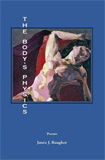September 25, 2013THE BODY’S PHYSICS
Review by Gregory Loselle
Tebot Bach
P.O. Box 7887
Huntington Beach, CA 92615-7887
ISBN: 9781893670006
2013, $16.00
tebotbach.org
Art imitates. So art also, naturally, imitates art. How could it be otherwise? The second cave painting must have emulated the first, and the second story ever told was a sequel. We crave more—and more from—what delights us. So when poetry crosses the boundaries of genre and takes as its subject another work, a visual work, we are in the realm of ekphrasis.
Ehphrastic poetry (the word is Greek and as old as the impulse it names) is a rejoinder; the first visual works must have illustrated, or embodied, myths. Ekphrasis returns the favor, preserving the need of the viewer to speak back—to comment, to answer, to complain or correct, to revel.
In The Body’s Physics, the new book of ekphrastic verse by Janée Baugher, not all poems are ekphrastic, but the collection begins with the impulse to meditate on the object and, in a series of deeply meditative and lyrical works, plumbs the depths in which object and observation meet. The eye is the constructor of sense and purpose here, and the voice of the poet, varied and fluent, speaks the sense of what she contemplates.
In considering Jackson Pollock’s Alchemy, for instance—a painting no less attractive for its own charms than for the transformation the title promises and Baugher’s poem enacts before us—the poet begins with imagining the artistic and alchemical Great Work at its outset:
Pollock parks the car-sized canvas on the floor
And begins by circling it, searching for gold, perhaps
Like one who searches water for wine.
All of the necessary elements are there, so to speak: the search for gold that starts in the artist’s initial encounter with the blank space (the beckoning absence, the ‘not there yet’ that mimics the poet’s vision of the painted work as well as her own, initially blank page), the drawing of the magic circle that traces Pollock’s famous working methods as he will later circle the canvas with a dribbling brush or wooden rod, the search for gold—in both painting and poetry, and the sly reference to the Wedding Feast at Cana, where the first Christian miracle, one of transformation that hints at the shift from human to divine that will take place. The “car-sized canvas” even evokes Pollock’s own death in an automobile accident—and his transformative resurrection through his enduring art.
But not just yet. Baugher places us at the creation of the work, and we become her fellow-witness. That is the transformation, in all its wonder, that she enacts for is—with us—through her work.
Similarly, we are present as “[a] ball of starlight unfurls itself/ and splays across dark, sulky water” in Van Gogh’s The Starry Night, Arles, and when she considers Picasso’s Guernica, not even the physical placement of the painting constrains us:
Though a metal bar holds us back fifteen feet. It seems possible
To mount the newsprint-patterned horse with a sword in its back, possible
To roll the decapitated open-eyed head from side to side, possible to hear
Wailing from the open-mouthed mother with limp babe in her arms.
Even if the poem eventually leaves us on “the gallery’s shiny floor,” we have walked, unscathed but not unaffected, through Picasso’s horrors.
So Janée Baugher has brought us into and out of a work with which we once thought ourselves familiar. It is the magic of The Body’s Physics that it leaves us with a richer experience, not only of the works from which it takes off, but of our own reactions to them as well.